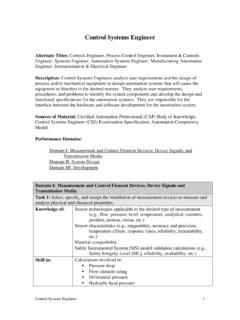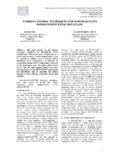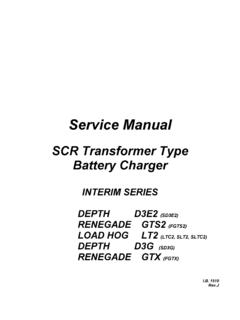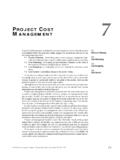Transcription of Control Systems Engineer - Automation Federation
1 Control Systems Engineer Alternate Titles: Controls Engineer , Process Control Engineer , Instrument & Controls Engineer , Systems Engineer , Automation Systems Engineer , Manufacturing Automation Engineer , Instrumentation & Electrical Engineer . Description: Control Systems Engineers analyze user requirements and the design of process and/or mechanical equipment to design Automation Systems that will cause the equipment to function in the desired manner. They analyze user requirements, procedures, and problems to identify the system components and develop the design and functional specifications for the Automation Systems . They are responsible for the interface between the hardware and software development for the Automation system . Sources of Material: Certified Automation Professional (CAP) Body of Knowledge, Control Systems Engineer (CSE) Examination Specification, Automation Competency Model.
2 Performance Domains: Domain I: Measurement and Control Element Devices; Device Signals, and Transmission MediaDomain II: system DesignDomain III: Development Domain I: Measurement and Control Element Devices; Device Signals and Transmission Media Task 1: Select, specify, and design the installation of measurement devices to measure and analyze physical and chemical properties. Knowledge of: Sensor technologies applicable to the desired type of measurement ( , flow, pressure, level, temperature, analytical, counters, position, motion, vision, etc.) Sensor characteristics ( , rangeability, accuracy and precision, temperature effects, response times, reliability, repeatability, etc.) Material compatibility Safety Instrumented system [SIS] model validation calculations ( , Safety Integrity Level [SIL], reliability, availability, etc.) Skill in: Calculations involved in: Pressure drop Flow element sizing Differential pressure Hydraulic head pressure Control Systems Engineer 1 Velocity, area, volumetric, density, and mass relationships Velocity, acceleration, mass, work energy Unit conversions Linearization Task 2: Select, specify, and design the installation of Control element devices to manipulate flows, energy, positions, speeds, and other variables.
3 Knowledge of: Control Element devices Pressure Relieving Devices Types ( , conventional spring, balanced bellows, pilot operated, etc.) Characteristics ( , modulating, pop action, etc.) Calculations ( , sizing considering inlet pressure drop, back pressure, multiple valves, etc.) Material selection based on process characteristics Installation practices ( , linking valves, sparing the valves, accessibility for testing, car sealing inlet valves, piping installation, etc.) Rupture discs (types, characteristics, application, calculations, etc.) Control Valves Types ( , globe, ball, butterfly, etc.) Characteristics ( , pneumatic or electric actuation, on/off, modulating, linear, low noise, equal percentage, shutoff class, etc.) Calculation ( , body and trim sizing, split range, noise, actuator sizing, speed, pressure drop, air/gas consumption, etc.)
4 Applications of fluid dynamics ( , cavitation, flashing, choked flow, Joule-Thompson effects, two-phase flow, etc.) Material selection based on process characteristics ( , erosion, corrosion, plugged, extreme pressure, temperature, etc.) Accessories ( , limit switches, solenoid valves, positioners, transducers, air regulators, etc.) Environmental constraints ( , fugitive emissions, packing, special sealing, etc.) Installation practices ( , vertical, horizontal, bypasses, troubleshooting, etc.) Motor Driven Control Elements Types of Motors ( Single and Polyphase Alternating Current (AC) Motors, Direct Current (DC) Motors, Stepper Motors, Servo Motors, linear, etc) Types of Motor Controllers or Drives ( full voltage, reduced voltage, reversing, variable frequency, adjustable DC, servo, stepper, etc.) Control Systems Engineer 2 Drive and/or Motor Characteristics ( solid state, constant torque AC, variable torque AC, vector AC, shunt wound DC, etc.)
5 Calculations ( horse power, torque, speed ranges, reduction ratios, etc.) Accessories ( speed sensors, encoders, etc.) Fluid powered actuators Pneumatic pistons Hydraulic pistons Sizing actuators and Control devices. Other Control Elements Solenoid valves On-off devices/relays Self-regulating devices Safety Instrumented system [SIS] model validation calculations ( , Safety Integrity Level [SIL], reliability, availability, etc.) Skill in: Installation Design ( , process, fluid power Systems , electrical, etc.) Calculations for: Valve sizing Power requirements Heat load, cooling, heating and space conditioning. Horsepower and torque Linear actuation force Etc. Task 3: Design and install wiring to reliably communicate information between measurement and Control element devices and Control equipment. Knowledge of: Control Signals Pneumatic, hydraulic, electronic, optical, discrete voltage, analog, digital, digital bus, etc.
6 Transducers ( , analog/digital [A/D], digital/analog [D/A], current/pneumatic [I/P] conversion, etc.) Electrical hazardous area classifications and required wiring and protection methods ( Intrinsic Safety, explosion proof, non-incendive, etc.) Grounding, shielding, segregation, AC coupling Basic signal circuit design ( , two-wire, four-wire, isolated inputs/outputs, loop or external powering, etc.) Signal Transmission Signal communications system architecture physical layers ( , fiber optics, coaxial cable, wireless, paired conductors, fieldbus, industrial networks, etc.) Signal Communications protocols ( foundation fieldbus, profibus, DeviceNet, ASi, Ethernet/IP, CAN, LonWorks, BACnet, etc.) Control Systems Engineer 3 Physical installation considerations versus transmission medium type Media types and specifications Voltage drop or signal attenuation Signal distortion due to media length or network structure Active and passive network components ( taps, splitters, repeaters/amplifiers, terminators, etc.)
7 Grounding & shielding Skill in: Electrical Installations Use of design standards and practices Determination of applicable codes. Calculations: circuit (voltage, current, impedance) Calculations: unit conversions Task 4: Calibrate, troubleshoot, test, repair, and improve sensing, measurement, and actuation devices. Knowledge of: Installation requirements ( , grounding, shielding, constructability, input/output termination, environmental, heat load calculations, power load requirements, purging, etc.) Functionality and performance of measurement and Control element devices Skill in: Commissioning ( , performance tuning, loop checkout, etc.) Troubleshooting ( , root cause failure analysis and correction) Domain II: system Design - do the complete conceptual design of the Control and information Systems including specifications of the hardware and software to be used in the system (sometimes called "front end engineering" or "basic engineering"); and also do the "detail design" and procurement of the hardware Systems including preparation of construction work packages.
8 Task 1: Perform safety and/or hazard analyses, security analyses, and regulatory compliance assessments by identifying key issues and risks in order to comply with applicable standards, policies, and regulations. Knowledge of: Additional Codes, Standards, and Regulations: American National Standards Institute (ANSI) Factory Mutual (FM) Institute of Electrical & Electronics Engineers (IEEE) International Society of Automation (ISA) National Electrical Code (NEC) National Electrical Manufacturers Association (NEMA) National Fire Protection Association (NFPA) Occupational Safety and Health Administration (OSHA) Underwriter Laboratory (UL) Equivalencies to international codes and standards Hazard analysis methodologies Risk analysis Control Systems Engineer 4 Safety system design ( , Safety Instrumented system [SIS], Safety Requirements Specification [SRS], application of OSHA 1910, etc.)
9 Skill in: Participating in a Hazard Operability Review Analyzing safety integrity levels Analyzing hazards Analyzing risks Assessing security requirements or relevant security issues Applying regulations to design Task 2: Establish standards, templates, and guidelines as applied to the Automation system using the information gathered in the definition stage and considering human-factor effects in order to satisfy customer design criteria and preferences. Knowledge of: Process Industry Practices (PIP) (Construction Industry Institute) IEC 61131 programming languages Customer standards Vendor standards Template development methodology Measurement and Control element devices Electrical standards and codes Instrument selection and sizing tools ISA standards ( , S5, S88) Etc. Skill in: Developing programming standards Selecting and sizing instrument equipment Designing instrument installations.
10 Designing low-voltage electrical Systems Preparing drawing using AutoCAD software Task 3: Create detailed equipment specifications and instrument data sheets based on vendor selection criteria, characteristics and conditions of the physical environment, regulations, and performance requirements in order to purchase equipment and support system design and development. Knowledge of: Measurement and Control element devices. Electrical standards and codes Instrument selection and sizing tools Vendors' offerings Motor and drive selection sizing tools Electronic Control system hardware ( controller, power supplies, input/output cards and chassis, communication hardware, etc.) Human Machine Interface (HMI) ( , graphics, alarm management, trending, historical data, etc.) Ergonomics ( , human factors engineering, physical Control room arrangement, panel layout) Skill in: Selecting and sizing motors and drives Control Systems Engineer 5 Selecting and sizing instrument equipment Designing low-voltage electrical Systems Selecting and sizing computers Selecting and sizing Control equipment Evaluating vendor alternatives Selecting or sizing of input/output signal devices and/or conditioners Task 4: Define the data structure layout and data flow model considering the volume and type of data involved in order to provide specifications for hardware selection and software development.






